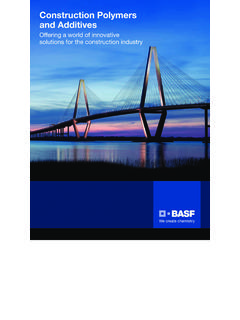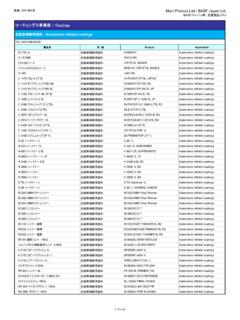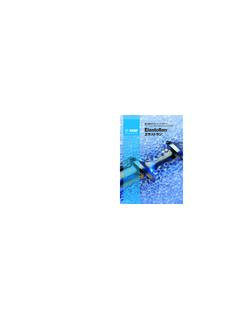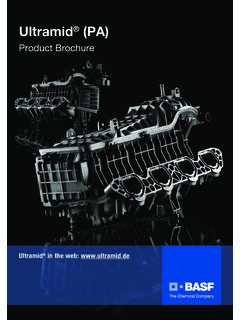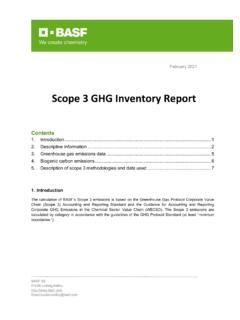Transcription of Acrylic acid glacial - BASF
1 Technical Information TI/CP 1593 e October 2017 Page 1 of 3 Supersedes edition dated February 2016 Petrochemicals Acrylic acid glacial Unsaturated monocarboxylic acid , for manufacturing polymers and for use as a feedstock for syntheses CH2 = CH C OH O CAS No.: 79-10-7 EINECS No.: 210-177-9 Product specification C3H4O2 Molar mass: The aforementioned data shall constitute the agreed contractual quality of the product at the time of passing of risk. The data are controlled at regular intervals as part of our quality assurance program. Neither these data nor the properties of product specimens shall imply any legally binding guaran- tee of certain properties or of fitness for a specific purpose and no liability of ours can be derived therefrom.
2 Other properties Labelling according to local Directives Appearance clear, colorless Physical form liquid at > 13 C Odor pungent Density at 25 C g/cm3 Refractive index nd at 20 C Boiling point 141 C Freezing point approx. 12 C Viscosity at 20 C mPa s Specific heat of liquid at 20 C kJ/kg C Heat of evaporation at boiling point 634 kJ/kg Heat of polymerization 1079 kJ/kg Heat of combustion at 25 C 19085 kJ/kg Vapor pressure at 20 C mbar at 40 C mbar Temperature rating for electrical equipment T 2 (300 450 C) Assay (Gas chromatography) Water content (ASTM E 203) Diacrylic acid content on despatch (gas chromatography) Color on dispatch (APHA, ASTM D 1209) Standard stabilization (HPLC basf or ASTM D 3125) min.
3 % max. % max. 2000 ppm max. 20 200 20 ppm MEHQ TI/CP 1593 e October 2017 Page 2 of 3 Acrylic acid glacial Applications Acrylic acid is an unsaturated carboxylic acid . It reacts as a vinyl compound and as a carboxylic acid . It readily undergoes polymerization and addition reactions. It can be used as a carboxylic acid to produce Acrylic esters, acrylamide, N-substituted acrylamides and acrylyl chloride by common methods. Copolymers can be produced with Acrylic and methacrylic esters, acrylo- nitrile, maleic acid esters, vinyl acetate, vinyl chloride, vinylidene chloride, styrene, butadiene and ethylene. Homopolymers of Acrylic acid and copolymers which contain a preponder- ance of Acrylic acid have a glassy consistency and are frequently soluble in water.
4 They can be used in the form of their free acids and ammonium and alkali salts in many different applications, such as thickeners, dispersing agents, flocculants, protective colloids for stabilizing emulsions and polymer dispersions, wetting agents, coatings and textile finishes. Acrylic acid readily undergoes addition reactions with a wide variety of organic and inorganic compounds. This makes it a very useful feedstock for the production of many low molecular compounds. For instance, Acrylic acid can be used to produce derivatives of propionic acid with water, alco- hols, amines, halogens and chlorinated hydrocarbons. It can also be used with other substances to produce unsaturated fatty acids, heterocyclic compounds and Diels-Alder addition products.
5 Processing Acrylic acid polymerizes very readily. It is generally stabilized with 200 ppm of hydroquinone monomethyl ether (MEHQ). It is only ever supplied in its stabilized form, because it can polymerize with explosive violence if it is not stabilized. It is not usually necessary to remove the stabilizer because its action can be compensated for by adding an excess of initiator. Storage & Handling In order to prevent polymerization Acrylic acid must always be stored under air, and never under inert gases. The presence of oxygen is required for the stabilizer to function effectively. glacial Acrylic acid must be stored between 15 and 25 C. For extended storage periods over 4 weeks it is advisable to replenish the dissolved oxygen content.
6 Under these conditions, a storage stability of one year can be expected. In order to minimize the likelihood of overstorage, the storing procedure should strictly follow the first-in-first-out principle. To prevent freezing, the temperature of Acrylic acid should never drop below 15 C. Improper thawing can result in violent polymerization. Do not attempt to thaw frozen or partially frozen Acrylic acid unless you have received prior approval from your supplier. It is highly recommended that an emergency restabilization systems is installed. This may help to prevent polymerization of the material in a situa- tion of pool fire, contamination or other unforeseeable events although it is no substitute for appropriate preventive measures.
7 For more detailed infor- mation please consult also the brochure SAFE HANDLING AND STORAGE OF Acrylic acid of EBAM. For a brochure or for more information please consult basf . Safety A Material Safety Data Sheet has been compiled for Acrylic acid that con- tains up-to-date information on all questions relevant to safety. TI/CP 1593 e October 2017 Page 3 of 3 Acrylic acid glacial Note The data contained in this publication are based on our current knowledge and experience. In view of the many factors that may affect processing and application of our product, these data do not relieve processors from carrying out their own investigations and tests; neither do these data imply any guarantee of certain properties, nor the suitability of the product for a specific purpose.
8 Any descriptions, drawings, photographs, data, pro- portions, weights etc. given herein may change without prior information and do not constitute the agreed contractual quality of the product. It is the responsibility of the recipient of our products to ensure that any proprietary rights and existing laws and legislation are observed. October 2017 basf SE Operating Division Petrochemicals Regional Business Unit Industrial Petrochemicals Europe 67056 Ludwigshafen, Germany Visit us online at

